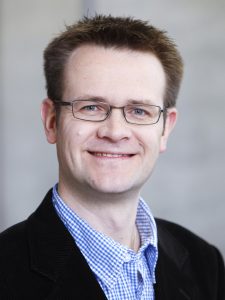 Thomas J. Schmidt is chair and professor of electrochemistry at ETH Zürich, and head of the Energy and Environment Research Division at Paul Scherrer Institute in Villigen, Switzerland, where he investigates various aspects of electrochemical energy conversion and storage. In 2010, he received the ECS Charles W. Tobias Young Investigator Award.
Thomas J. Schmidt is chair and professor of electrochemistry at ETH Zürich, and head of the Energy and Environment Research Division at Paul Scherrer Institute in Villigen, Switzerland, where he investigates various aspects of electrochemical energy conversion and storage. In 2010, he received the ECS Charles W. Tobias Young Investigator Award.
Schmidt has recently been reappointed as an associate editor of the Journal of The Electrochemical Society (JES) and handles manuscripts submitted to the fuel cells, electrolyzers, and energy conversion topical interest area.
The Electrochemical Society: How would you describe your experience as a JES associate editor?
Thomas Schmidt: I became an associate editor in 2014, and it is a great experience. First of all, it keeps me connected to the great research the community and our authors are performing. From every paper I read as an associate editor, I get educated and I learn something new. Very often, I get excited by the great ideas I read in the manuscripts. On the other hand, it is also highly educational to develop an understanding for work which is lacking experimental depth. Additionally, it is also very rewarding to support the best community journal in electrochemistry—to help to develop its content and impact.
ECS: What separates ECS journals from other journals in the field?
TS: ECS journals are community journals with broad content in electrochemistry along our topical interest areas. In that sense, however, it still remains very focused. ECS is one of the few remaining nonprofit publishers in the multimillion dollar scholarly publishing business. That is, ECS journals are made by the community for the community, which in my opinion makes the Journal of The Electrochemical Society so strong. This is also one of the reasons I enjoy supporting ECS journals as both an associate editor and an author.
ECS: Why is the peer review process so important in scholarly publishing?
TS: In my opinion, there is one simple answer: it ensures the quality of the published work in a journal. Our reviewers are always from the field, so we can rely on the fact that they are knowledgeable about the different topics they are assigned to in the review process. In addition, the technical editors as well as the associate editors are from the field, ensuring an additional quality control step. This way, the manuscripts which finally get published are assessed on their quality and excellence, and not by means of what good story they will make on the journal cover.
ECS: How will open science impact the future of scientific research?
TS: This is a quite complex question. In general, the idea is to make science and its results accessible to everyone, which conceptually is a great idea. However, the impact of the different initiatives around open science (e.g., open access publishing, open data, etc.) is very difficult to foresee. Publishing open access should be mandatory, and we already see the positive impact this creates in spreading the work. On the other hand, open data is, in my opinion, a very critical question. Take the example of work being performed on a beamline of a synchrotron or a free electron laser. Within a day of experiments, you can create terabytes of raw data, which are analyzed and reduced to secondary data (often automatically by intelligent algorithms) you start to work with. Your secondary data will then be distilled down to a small fraction of the original data to what will end up in a manuscript or a thesis. So what data need to be accessible and in which format? Do we need to make raw data/primary data accessible? And for how long or after what embargo period? These are unresolved questions at the moment, and data policies will be different from country to country and maybe even from institution to institution.
ECS: What type of research are you currently focusing on?
TS: My own research is focused around all aspects of electrochemical energy conversion and storage. The main topics are focused around hydrogen from production to conversion, where we are working basically on all technology readiness levels (TRLs) until we reach TRL 5 or 6, respectively. One the one hand, we look into fundamental processes on electrocatalysts; on the other hand, we are developing and operating fuel cell and electrolysis systems including their integration. This broad TRL field can only be covered at places like Paul Scherrer Institute with its fantastic infrastructure, like a synchrotron, a neutron source, and a free electron laser.


